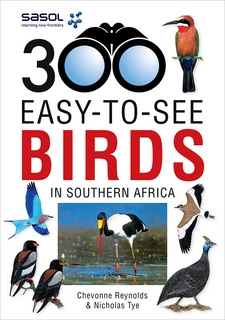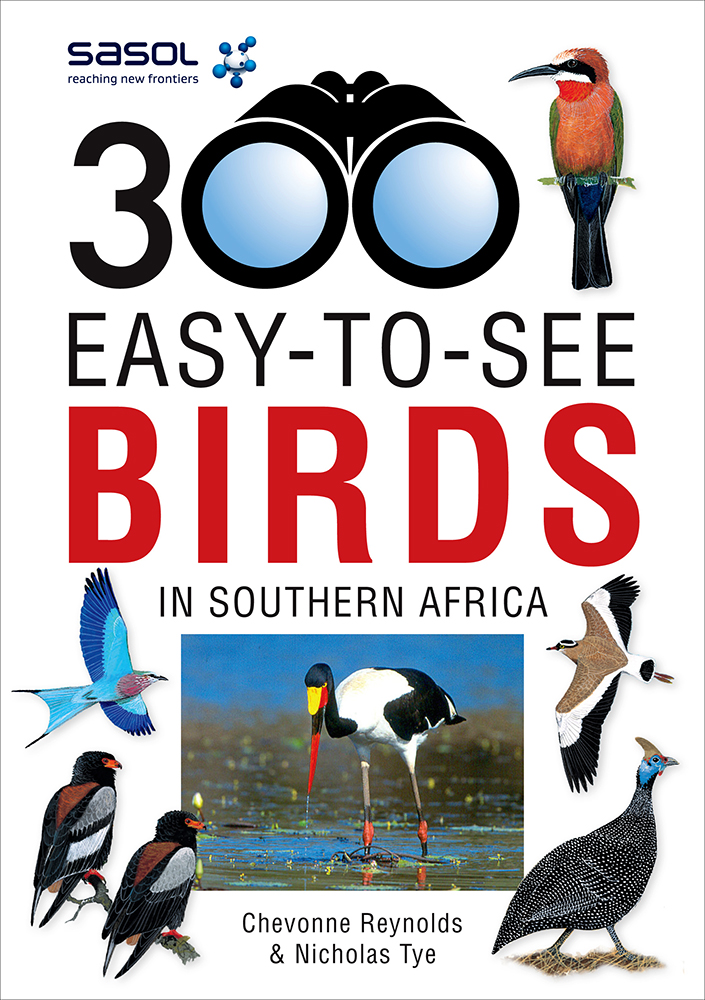300 Easy-to-See Birds in Southern Africa, by Chevonne Reynolds and Nicholas Tye

300 Easy-to-See Birds in Southern Africa, by Chevonne Reynolds and Nicholas Tye. Penguin Random House South Africa (Struik Nature). Cape Town, South Africa 2015. ISBN 9781775841265 / ISBN 978-1-77584-126-5
300 Easy-to-See Birds in Southern African by Chevonne Reynolds and Nicholas Tye combines simple text with illustrations and photographs to enable quick and sure ID of 300 of the region's most common species.
Throughout the world, millions of people enjoy watching birds. Many watch birds simply because they find them beautiful and fascinating; others because they like to spend time in natural surroundings. For some the thrill is in finding particularly rare birds. For us, birdwatching is not just about finding and identifying birds, it's an activity that has a profound influence on our daily lives. Birding encourages us to be adventurous and explore our surroundings, whether it is an afternoon walk around our local park or a long trip to a part of the country to which we would otherwise never have ventured. It gets us out into nature and connects us to some of the challenges our environment faces. It teaches us to be patient and quiet. It has no limitations of space or time and can be enjoyed anywhere and with anyone. There is no telling what you may gain from watching birds, so go on and give it a try!
Birdwatching: a southern African perspective
The southern African region is defined as the area south of the Kunene, Okavango and Zambezi rivers and encompasses the countries of Namibia, Botswana, Zimbabwe, South Africa, Lesotho, Swaziland and southern Mozambique. It also includes the oceanic waters within 200 nautical miles of the coast. The region is extraordinary from a birdwatcher's perspective because it hosts a total of 967 bird species. This represents nearly 1 0% of the world's bird diversity. This incredible total continues to grow as vagrant species enter the region or new species are recognised. Southern Africa also boasts the highest levels of endemic species (which occur and breed only in the region) and near-endemic species (which have ranges that extend just beyond the region's boundaries) on the African continent. Southern Africa owes its incredible bird diversity to the variety of environments contained within its borders. The combination of differing rainfall patterns (ranging from high in the east to low in the west), varying topography (from the high mountains of Lesotho to the wide coastal plain) and diverse geology provides an assortment of environments for birds to exploit. These environments can be broadly classified into eight biomes, based largely on the general plant types they support (see map).
Selection of the 300 species
The relative ease with which a species can be seen in southern Africa was the main consideration when selecting the 300 that are presented in this book. Therefore the majority of species described are generally widespread, common and conspicuous and are found in places that are easily accessible. Further to this, at least one species from all the main bird families is included, in order to introduce the user to the wonderful diversity of birds in southern Africa. An effort was also made to avoid including species that are particularly difficult to identify, such as pipits. Finally, a few species are featured that are a bit more difficult to locate but are particularly colourful and interesting, such as Narina Trogon. [...]
This is an excerpt from 300 Easy-to-See Birds in Southern Africa, by Chevonne Reynolds and Nicholas Tye.
Title: 300 Easy-to-See Birds in Southern Africa
Authors: Chevonne Reynolds, Nicholas Tye
Publisher: Penguin Random House South Africa (Struik Nature)
Cape Town, South Africa 2015
ISBN 9781775841265 / ISBN 978-1-77584-126-5
Softcover, 15 x 21 cm, 168 pages, 1000 colour photographs
Reynolds, Chevonne und Tye, Nicolas im Namibiana-Buchangebot
300 Easy-to-See Birds in Southern Africa
300 Easy-to-See Birds in Southern Africa is aimed at beginner birders, or even juniors.

